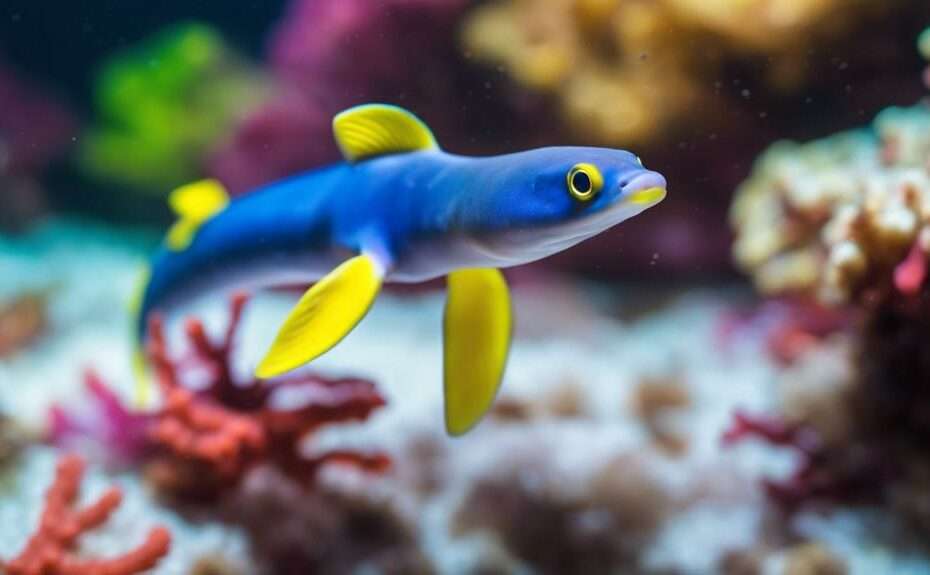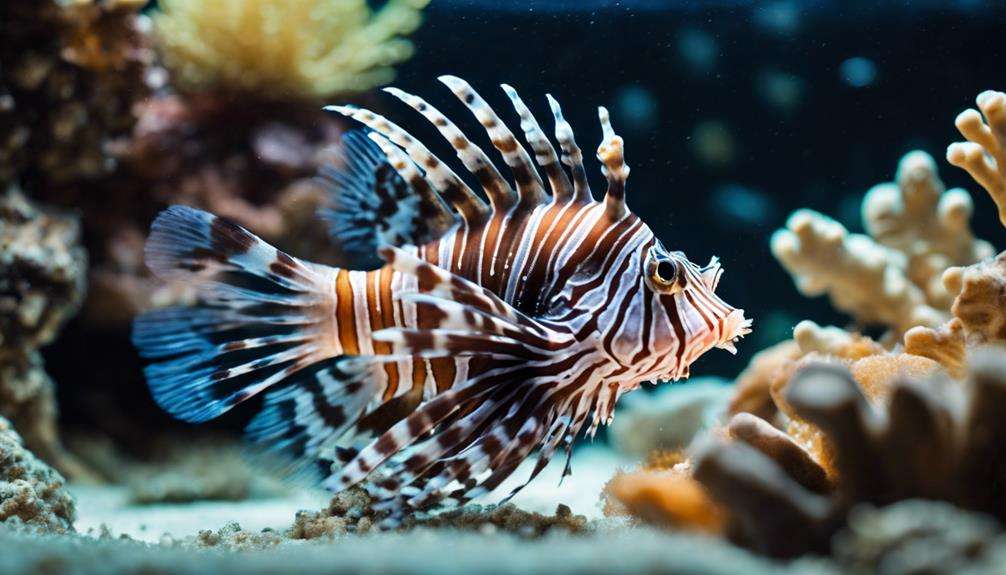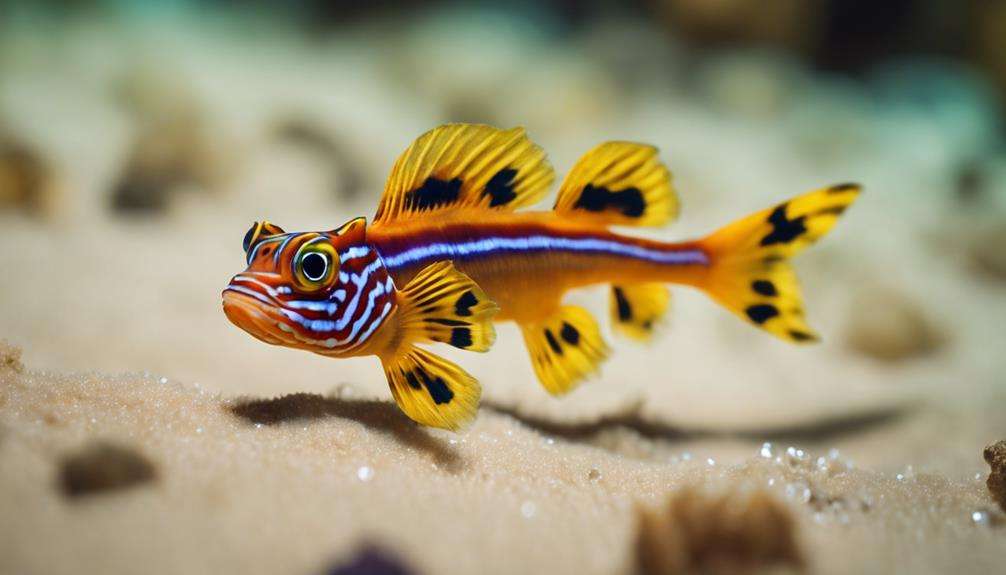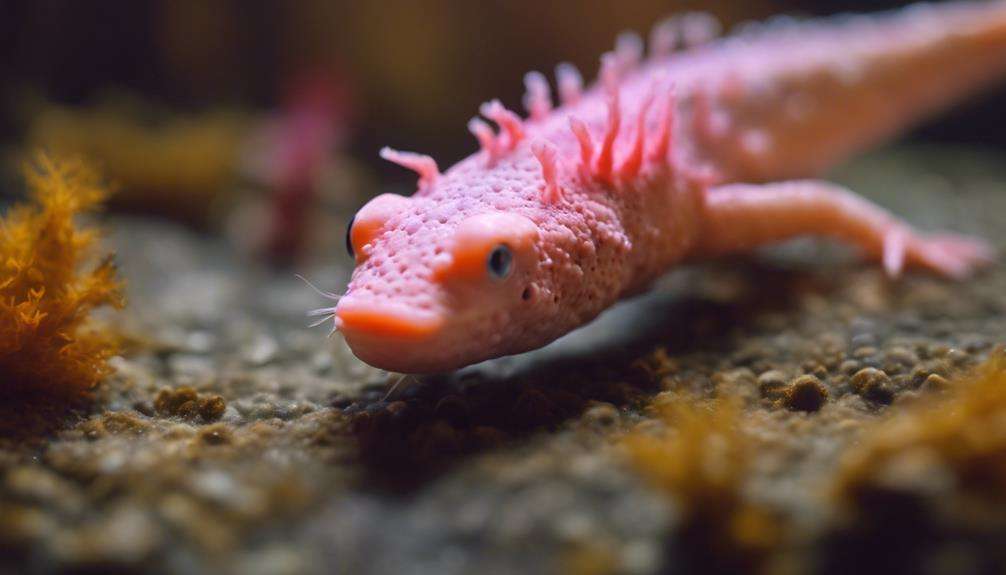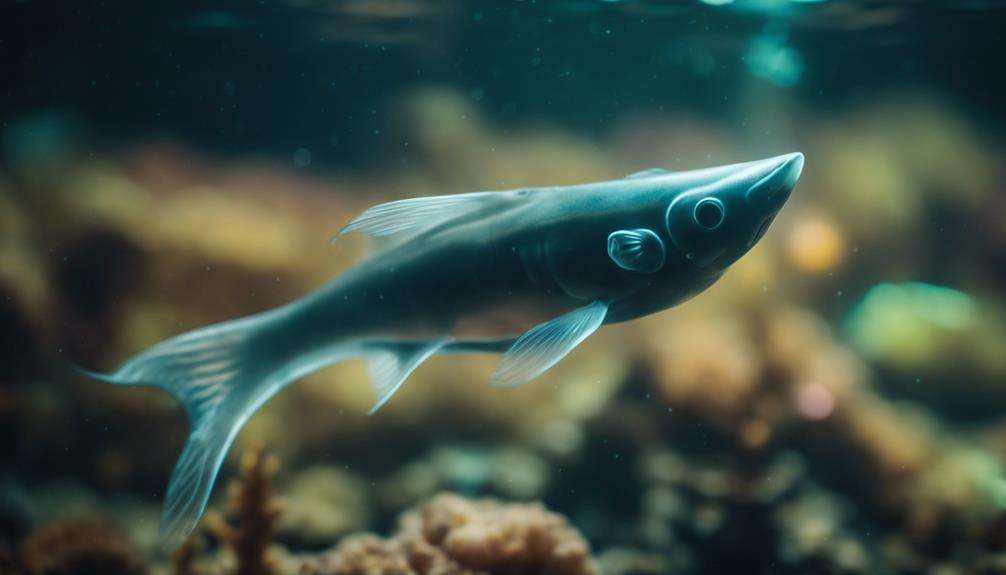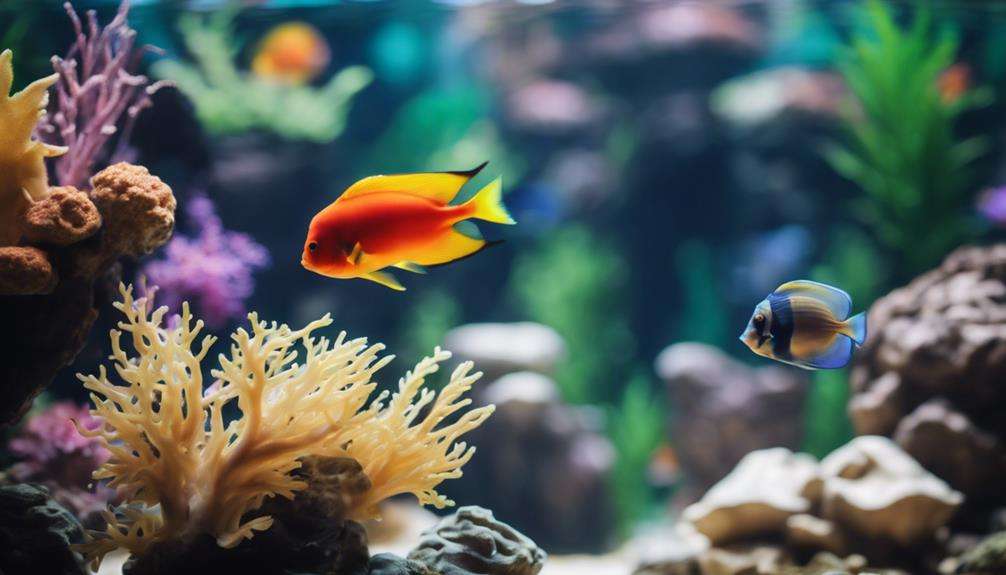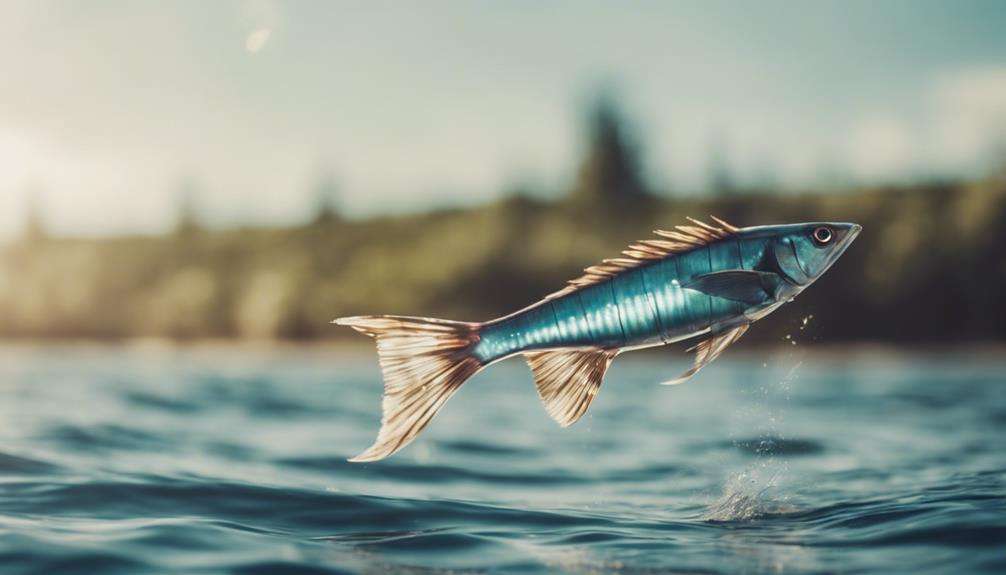As you explore the intricacies of caring for Ribbon Eels, you'll find that maintaining these creatures in your aquarium requires a tailored approach that goes beyond the basics.
From their unique tank requirements to the delicate balance of water conditions, there are essential tips and guidelines that can make all the difference in their well-being and longevity.
It's not just about keeping them alive but creating an environment where Ribbon Eels thrive and display their full beauty.
Let's unravel the secrets to successfully caring for these mesmerizing creatures.
Key Takeaways
- Maintain a tank with 55+ gallons, secure lid, and live rock for ribbon eel growth.
- Ensure stable water conditions: 78-82°F temperature, 1.023-1.025 salinity, and pH 8-8.2.
- Create a suitable environment with subdued lighting, hiding spots, and proper aquascaping.
- Select peaceful tank mates, monitor health regularly, and prevent diseases through water quality management.
Tank Requirements for Ribbon Eels
When setting up a tank for Ribbon Eels, ensure a minimum volume of 55 gallons to accommodate their potential growth up to 4 feet. Ribbon eels require ample space to move around comfortably, and larger tanks are recommended to mimic their natural habitat accurately. It's crucial to have a secure lid on the tank to prevent these eels from jumping out, as they're known for their occasional jumping behavior, which could lead to injuries outside the water.
In the captive environment, Ribbon Eels prefer to spend their time coiled behind rocks or in crevices. Therefore, incorporating adequate live rock formations in the tank is essential to provide hiding spots for these eels. This not only helps mimic their natural behavior but also reduces stress levels in captivity.
Observing their mesmerizing swimming behavior, resembling ribbons flowing through the water, is a delight for any aquarist. Creating a suitable environment in the tank that supports their swimming habits is crucial for the well-being of Ribbon Eels in captivity.
Ideal Water Conditions for Ribbon Eels
Maintaining water temperatures between 78-82 degrees Fahrenheit is crucial for the health of ribbon eels.
Additionally, ensuring salinity levels fall between 1.023 to 1.025 is essential for their well-being.
Keeping pH levels within the range of 8-8.2 is also critical to support the longevity of ribbon eels in captivity.
Water Temperature Requirements
To ensure the optimal health and well-being of ribbon eels, it's imperative to maintain a consistent water temperature between 78-82 degrees Fahrenheit. Ribbon eels thrive within this ideal temperature range, and any fluctuations outside this range can stress them, leading to potential health issues.
Monitoring the water temperature regularly and making necessary adjustments are crucial aspects of caring for ribbon eels. It's essential to have a reliable heater in place to ensure that the water temperature remains within the recommended range for these delicate creatures.
Water Quality Considerations
Achieving ideal water conditions for Ribbon Eels involves closely monitoring and maintaining specific parameters such as temperature, salinity, pH levels, and key water quality indicators.
Ribbon Eels thrive in water temperatures ranging from 78-82°F, mirroring their natural habitat. It's crucial to maintain a salinity level between 1.023-1.025 to support proper osmoregulation for these eels. Keeping the pH of the water within 8-8.2 is essential for their health and well-being.
To mimic ocean water quality, it's important to keep ammonia, nitrites, and nitrates at low levels. Consistent water quality is vital for the overall health and longevity of Ribbon Eels in captivity. By diligently monitoring and adjusting these factors, you can provide a suitable environment for your Ribbon Eel.
Lighting Needs for Eels
For optimal care of Ribbon Eels, ensuring appropriate lighting conditions in their aquarium is crucial to replicate their preferred natural habitat. Ribbon eels prefer subdued lighting in aquariums, resembling the dimly lit ocean where they dwell.
Maintaining water temperatures between 78-82 degrees Fahrenheit is ideal for these eels. It's crucial to monitor and adjust the pH level in the aquarium to keep it within the range of 8.0-8.2 for the health and well-being of ribbon eels.
Additionally, maintaining a salinity level of 1.023-1.025 is essential to mimic their oceanic environment accurately. Consistent water quality with low levels of ammonia, nitrites, and nitrates is paramount for successful ribbon eel care.
Aquascaping Tips for Ribbon Eels
When designing the tank environment for Ribbon Eels, ensure ample hiding spots like PVC pipes and rock structures are incorporated to provide security and reduce stress levels.
It's crucial to fasten live rock securely to prevent potential collapses that can harm the eel during its exploration.
Remember to create a setup that mimics their natural habitat, offering a mix of open swimming space and sheltered areas to promote their well-being.
Tank Environment Setup
To create an ideal tank environment for ribbon eels, ensure that your aquascape incorporates multiple hiding spots and secure hideaways to cater to their territorial nature. When setting up the tank for your ribbon eel, consider the following:
- Tank Size: Provide a tank of 55-75 gallons for a single eel, and 75-90 gallons for multiple eels to allow them ample space to move around.
- Tank Mates: Choose tank mates wisely, opting for deep-bodied fish that are peaceful to avoid conflicts in the tank.
- Water Conditions: Monitor water parameters closely, maintaining temperature (72-82℉), pH (8.1-8.4), and salinity (1.020-1.025) at optimal levels for the eel's well-being.
Hiding Spots Design
Incorporate PVC pipes or rock crevices in your aquarium design to provide secure hiding spots for Ribbon Eels, ensuring their comfort and minimizing stress levels. Ribbon Eels are known to seek shelter in tight spaces, feeling protected in confined areas. Utilizing PVC pipes or natural rock formations within the tank allows these eels to retreat and feel secure.
A closed-loop system with glass lids is crucial to prevent escapes, safeguarding the eel's safety. It's essential to cover any areas with equipment like skimmers to avoid entrapment risks. Creating a diverse environment with live rock structures mimics the eel's natural habitat, encouraging exploration.
Always keep the tank top covered to prevent accidental escapes and maintain the eel's well-being in captivity.
Feeding Guidelines for Ribbon Eels
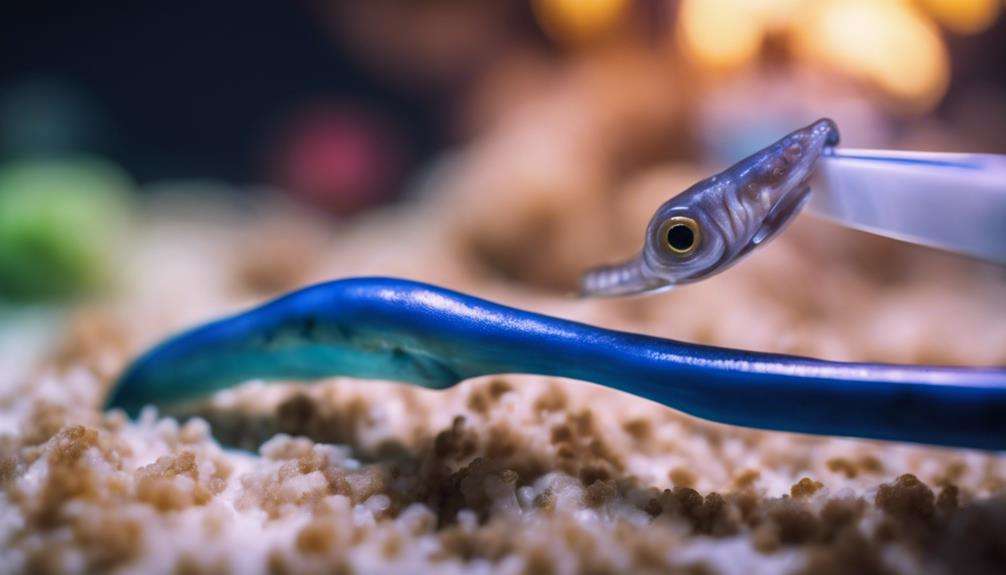
How can you ensure the optimal feeding regimen for Ribbon Eels in captivity?
Ribbon Eels are known to be picky eaters, typically preferring live prey such as small fish with red or orange coloration. When transitioning them to captivity, feeding challenges may arise, requiring patience and persistence. To encourage feeding, soaking their food in garlic can help stimulate their appetite. It's crucial to avoid offering freshwater fish to Ribbon Eels and stick to marine options instead to meet their dietary needs adequately. Monitoring the eel's feeding behavior is essential to ensure that it adjusts well to captivity and maintains a healthy diet.
- Provide live prey such as small fish with red or orange coloration.
- Be patient and persistent during the acclimation process.
- Use garlic to stimulate the eel's appetite and encourage feeding.
Compatible Tank Mates for Ribbon Eels
When selecting tank mates for Ribbon Eels, prioritize peaceful species like gobies and blennies to prevent aggression and ensure a harmonious aquarium environment. Ribbon eels are best suited to companions that aren't aggressive or territorial, as these traits can lead to stress and potential conflicts.
Providing hiding spots and ample space for each eel is crucial in reducing tension among tank mates. Due to their unique feeding requirements, it's recommended to keep Ribbon eels in a species-only tank. However, if considering a mixed-species setup, compatibility with peaceful species such as Angelfish, Groupers, Lionfish, Rabbitfish, and Tangs can be explored.
These species can coexist with Ribbon eels without posing a threat. Ensuring a peaceful community of tank mates is essential for the well-being of Ribbon eels and the overall balance of the aquarium ecosystem.
Gender Differences in Ribbon Eels
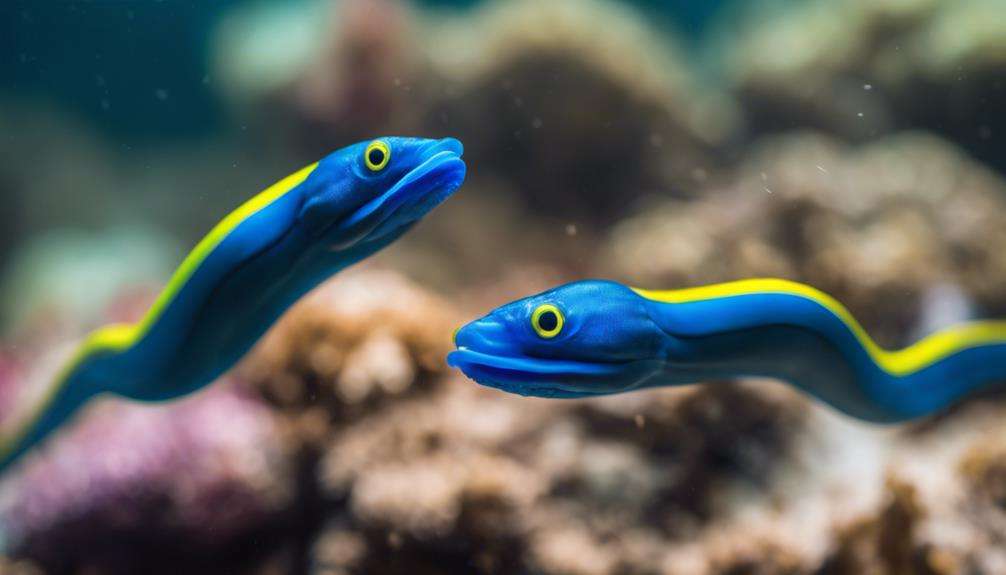
Male Ribbon Eels exhibit a predominantly black coloration, while females undergo a striking transition from blue to yellow as they mature. This distinct difference in coloration is a fascinating aspect of their biology and plays a crucial role in their gender identification.
Here are some key points to understand the gender differences in Ribbon Eels:
- Ribbon Eels are protandric hermaphrodites, starting as black males and transitioning into yellow females as they mature.
- The color changes in Ribbon Eels are directly linked to their sex, with males retaining their dark hues and females displaying vibrant yellow tones.
- Sex determination in Ribbon Eels can be visually observed through their unique color shifts from the juvenile stage to adulthood, providing insights into their reproductive biology and behavior.
Understanding these gender variances is essential for caretakers, especially in captivity breeding programs, to ensure the well-being and successful reproduction of these captivating marine creatures.
Health and Disease Management for Ribbon Eels
To effectively manage the health and prevent diseases in Ribbon Eels, it's essential to understand their susceptibility to environmental factors and common ailments. Ribbon eels are particularly vulnerable to ammonia and nitrate poisoning, necessitating the maintenance of low levels of these compounds to ensure their well-being.
Common diseases that affect ribbon eels include skin flukes, parasitic infections, and bacterial infections, all of which require immediate treatment to avoid further complications. Stress induced by poor water quality or inappropriate tank conditions can compromise the eels' immune systems, heightening their susceptibility to diseases.
Quarantining new tank mates and closely observing any signs of illness in ribbon eels can help prevent disease outbreaks and maintain a healthy aquatic environment. Regular water testing and monitoring of tank parameters are vital practices in preventing health issues and providing the best care for ribbon eels.
Responsible Breeding Practices for Ribbon Eels
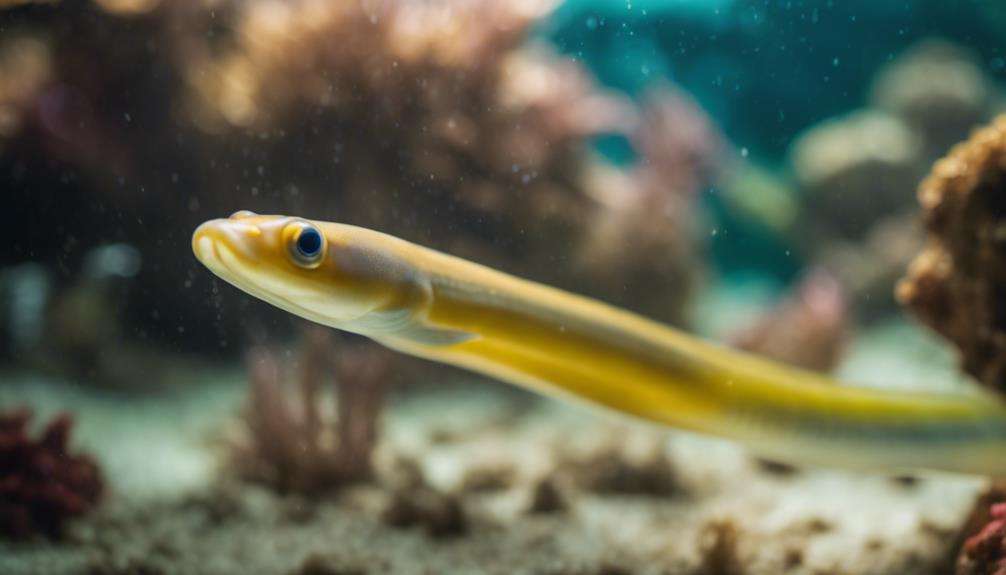
Understanding the intricate complexities of Ribbon eels' natural breeding behaviors is paramount in establishing responsible breeding practices for these challenging species in captivity. Ribbon eels present unique challenges for captive breeding due to their specific feeding habits and environmental requirements. Observing their protandric hermaphroditism, where they transition from male to female in the wild, highlights the need for careful consideration in replicating natural conditions in captivity.
Here are three key points to focus on when engaging in responsible breeding practices for Ribbon eels:
- Environmental Requirements: Mimicking their natural habitat conditions, such as water quality and tank setup, is crucial for successful breeding attempts.
- Feeding Habits: Understanding and catering to their specific feeding preferences and behaviors can enhance breeding success and overall health.
- Breeding Behaviors: Observing and responding to their territorial behavior and potential sex changes during the breeding process is essential for successful captive breeding efforts.
Frequently Asked Questions
How Do You Take Care of Ribbon Eels?
To care for ribbon eels, set up a 55-gallon tank with hiding spots. Maintain water parameters (temp 78-82°F, salinity 1.023-1.025, pH 8-8.2). Offer live prey, monitor temperature, provide suitable lighting, avoid handling, enrich habitat, observe swimming behavior, and prevent diseases.
How Often Should You Feed a Ribbon Eel?
You should feed a ribbon eel 2-3 times weekly. Monitoring its appetite and adjusting the diet as needed are crucial. Offering a variety of foods and observing feeding behavior helps determine the best feeding schedule.
How Do You Take Care of an Eel?
To care for an eel, maintain a spacious tank with proper water conditions, provide a varied diet, offer hiding spots, regulate lighting and temperature, handle cautiously, be aware of behavioral traits, and ensure compatibility with tank mates.
Are Blue Ribbon Eels Hard to Keep?
Keeping Blue Ribbon Eels can be challenging due to their specific care needs. Tank requirements include pristine water conditions. Their territorial nature and feeding habits make them better suited for species-only tanks, requiring experienced aquarists.
Conclusion
In conclusion, maintaining optimal tank conditions for Ribbon Eels is crucial for their well-being.
Did you know that Ribbon Eels can grow up to 3 feet in length and live up to 20 years in captivity?
By following the care tips and guidelines outlined in this guide, you can ensure a healthy and thriving environment for these fascinating creatures in your aquarium.
Remember, proper care and attention are key to the longevity and happiness of your Ribbon Eels.
